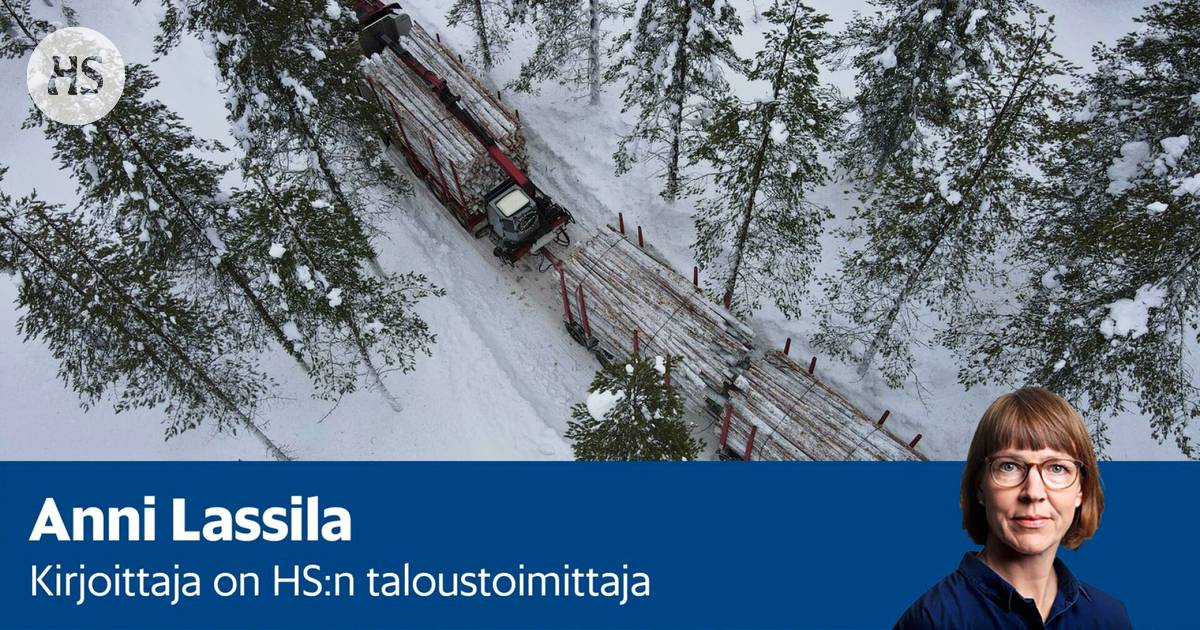Forestry companies are now rushing to clear the forests of Northern Finland, because there can still be increased logging. New factories increase the use of wood, and at the same time conservation measures can reduce the land area available for forestry. HS tried to find out if the tree will run out in the future.
Comment was stunning.
“It’s quite clear that a period of scarcity is beginning when it comes to harvesting quantities,” said the CEO of forest industry giant Metsä Group Ilkka Hämälä at the end of March In the HS article.
The company is building a huge new pulp mill in Kemi, and the CEO talks about the wood shortage. What exactly is it about?
The import of wood from Russia ended a year ago due to the war. In recent years, more and more wood has also ended up in the boilers of thermal power plants. At the same time, the protection of forests is being increased and the forest industry is nevertheless investing in new production.
The equation seems contradictory. If the wood is really running out, why invest? HS decided to study statistics and interview experts to find the truth about the tree situation and its consequences.
It wasn’t quite that simple.
How much wood is needed?
A tree having enough or running out depends at least on how much wood is needed. Last year, 74.7 million cubic meters of trunk wood was cut from Finnish forests, according to preliminary data collected by the Finnish Natural Resources Agency (Luke). In the forestry sector, a cubic meter is usually spoken of as a motto.
Out of the total amount of felling, just under seven million mots were used for heating small houses or for other household needs. Four million motes were chopped for fuel for thermal power plants.
The actual wood processing industry used 63.8 million tons of trunk wood. A good half of it was fiber wood used by factories producing pulp and mechanical pulp, the rest saw logs.
Industry the need for wood will grow rapidly in the next few years, if it is estimated based on the investments that have already been decided or are under construction.
The largest individual increase in the use of wood is Metsä Group’s pulp mill in Kemi, which will be completed in the fall. The company has also built a large new sawmill in Rauma. In total, they increase the company’s wood procurement by almost six million Mot per year.
Luke’s special researcher Antti Mutanen also other sawmill companies such as Junnikkala, Pölkky and Versowood have made investments recently.
“If nothing is closed, the net increase in sawing capacity will be around two million cubic meters in total. The pulp mill projects in Kemijärvi and Paltamo are also still on the planning table,” says Mutanen.
It has been calculated in Luke that the investments will increase the need for wood by a total of approximately 6–8 million cubic meters. The reading depends on whether one more pulp mill will be built in Lapland.
Also the import of wood from Russia, which ended last year, will mainly be replaced with domestic wood. Of course, it has already been partly replaced, because the import stopped about a year ago. However, not completely.
About ten million cubic meters of wood chips and birch trunks came from beyond the eastern border per year. Wood chips were used both for energy production and as raw material for pulp mills.
Stora Enso imported about 2.5 million cubic meters of pulpwood and wood chips from Russia. Last year, according to HS, procuring a replacement tree from home was successful. The company at the Uimaharju pulp mill has moved to use softwood instead of birch.
UPM was a big user of birch imported from Russia. The company made short-fiber pulp from it, for example, at the Kaukaan factory in Lappeenranta. The raw material of plywood factories is also birch. Birch grows relatively little in Finnish forests.
UPM has since moved the short-fiber pulp line to Kaukaa to make long-fiber softwood pulp. All in all, the end of imports from Russia will increase UPM’s domestic wood procurement by approximately two million mots, according to HS data. Part of it is already included in last year’s application figures.
Power plants of energy companies that burned Russian wood chips have also had to obtain firewood from domestic forests. At its worst, it has led to the burning of virgin forests.
Read more: Saariselkä’s holiday oasis is heated with trees from pristine virgin forests – “There is no other solution”
How much wood can be cut from forests?
Finland around 75 million cubic meters of trunk wood were cut from the forests last year, slightly more than the previous year.
According to special investigator Mutanen, the investments and the replacement of Russian imports together mean that in the coming years the amount of felling will be very close the largest maintainable logging accumulation i.e. about 86.3 million cubic meters per year.
So close to what?
The maximum maintainable logging accumulation is not the same as the annual growth of forests. Forests grow much more, more than one hundred million motes per year.
However, Luke regularly assesses how much of the forests in commercial use can practically be felled so that the felling volumes remain constant in the long future and the fellings are financially profitable.
Calculus is based on the so-called forest inventory. It is a huge and continuous exercise, where Luke’s researchers monitor the volume and growth of trees, deforestation and other forest developments in 60,000 test plots. Measurements are made both on the stand level and on individual trees.
On the basis of the collected data, the researchers then model what are the opportunities for felling the forests and how they will develop in the future.
“The largest maintainable logging accumulation estimate takes into account the economic profitability of the operation and the sustainability of wood production in the long term. The assessment has taken into account the valid recommendations of forest management, such as leaving saving trees in the forest and protected areas and leaving dead trees out of harvesting,” specialist researcher Hannu Hirvelä From Luke says.
Current the estimate is that until 2045, an average of 86.3 million tons of trunk wood per year can be cut from forests across the country.
According to Hirvelä, the latest assessment has not taken into account recent indications of a slowdown in the growth of forests, because their significance in the long term is not known.
“In the future, we will see how it might affect it. It would seem that there is a yearly variation in the reasons leading to a decline in growth, such as drought and good seed years,” he says.
Average therefore, from the point of view of wood production, there would still be room to increase felling. But this only applies to part of Finland. In recent years, the logging in Uusimaa, Kanta-Hämee, South Karjala and Kymenlaakso has exceeded the maintainable amount of logging.
“You have to remember that going over a few years is not a problem yet,” says Hirvelä.
That’s why forest companies are now heading to Lapland. There and in Kainuu there are the most opportunities to grow logs. Metsä Group is not the only company that plans to utilize Lapland’s forests.
Last fall, UPM also hired wood buyers for the Rovaniemi–Kuusamon axis in Northern Finland. Although Luke’s assessments are not a guideline, they are nevertheless relied upon and used to justify actions.
Current the estimate of sustainable logging is not the final truth. Antti Mutanen considers it realistic that the demands coming from the EU to protect old forests and biodiversity will reduce logging opportunities.
Luke has calculated that the logging level corresponding to the maximum maintainable amount of logging would mean an increase in the carbon stock contained in the trees and soil of the forests. Forests would therefore remain a carbon sink.
However, maintaining diversity is another matter. In Finland, there are several working groups that consider the definition of old forests to be protected as well as how to implement biodiversity protection.
Nature panel has demanded that the ten percent strict protection goal must be implemented on a province-by-province basis, because, for example, it is impossible to protect southern habitats in northern Finland.
According to Mutanen, this approach would mean a reduction in logging opportunities by around 7–11 million cubic meters per year.
A tree there has been a lot of talk about energy use lately. It is due to the fact that, last winter, considerable amounts of wood suitable for processing and, as mentioned earlier, even wood from virgin forests have ended up in the furnaces of the power plants.
However, according to forest experts, wood that has no other use would also be available for boilers. It is typically a thin trunk that can be harvested in the first thinnings done early enough, which is not yet suitable for the pulp boiler.
According to Luke’s estimate, the amount of energy wood will increase in the coming years. However, it requires that economic forests are thinned in time.
Read more: A strict line on wood burning will not be implemented – Ville Niinistö: It must be ensured that quality wood is not burned
What about your relationship?
A tree running out or having enough is ultimately relative. It is clear that in the next few years the balance between supply and demand for wood will be tight. How tight? It depends, among other things, on decisions regarding protection criteria.
However, in a market economy, things tend to find a balance. When the demand for wood increases and the supply decreases, its price rises. According to Luke’s statistics, the carrying price of pine fiber wood has increased by as much as 40 percent per year. The forest owners have benefited from it.
At some point, the upper limit of the price increase is reached, i.e. the wood is too expensive compared to the production costs and sales price of softwood pulp. These, in turn, are affected by the demand and supply situation in the world market as a whole.
Pulp the price has been high for two years already, which is an exceptionally long time in a cyclically sensitive industry. Before long, the situation will turn around.
It may be that older, smaller pulp mills in Finland or nearby areas will catch up, when highly efficient giants like the new mill in Kemi drive them out of the market.
Lumber prices rose to unprecedented heights in the renovation boom of the corona epidemic. However, the sawmill industry has already turned and the construction industry is in a slump. The sawmills may also face a playoff game.
If the demand for forest industry products weakens, it will also be immediately reflected in the amount of felling. The change can be very fast.
#Analysis #Northern #Finlands #forests #felled #competition #journalist #Anni #Lassila #wood





/s3/static.nrc.nl/liveblog/files/2024/04/anp-496998518.jpg)



